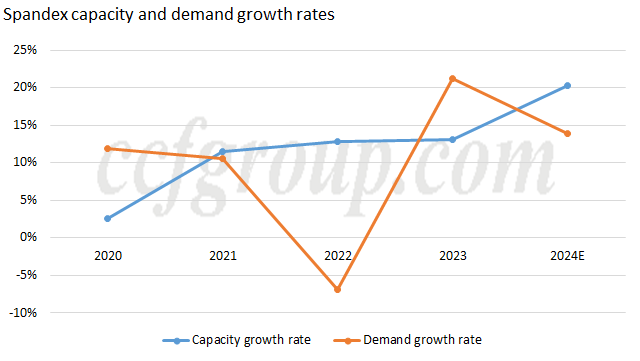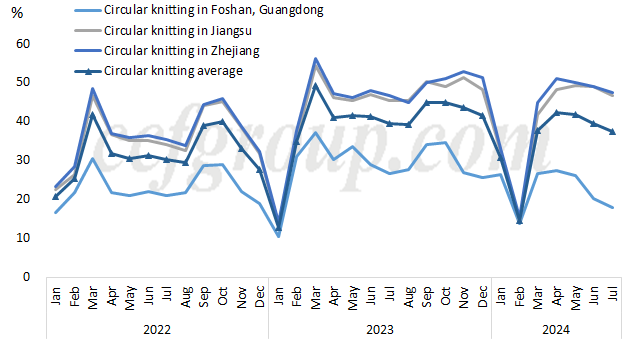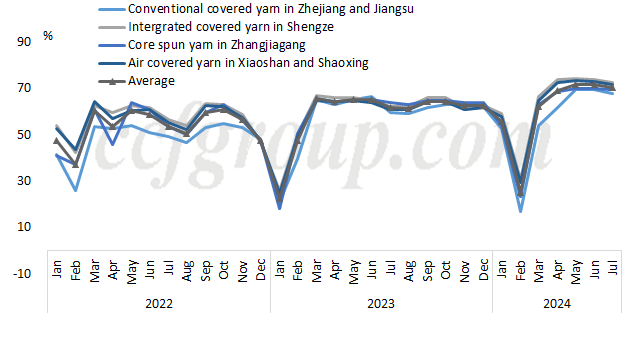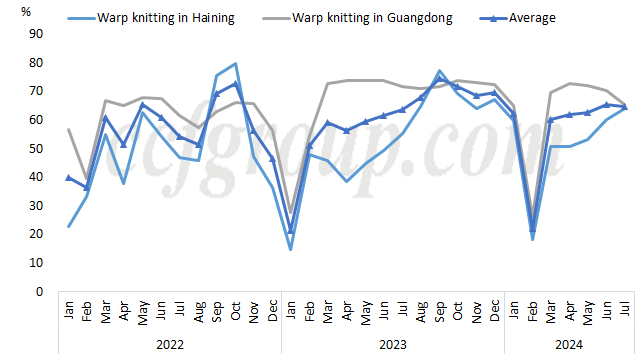Spandex demand analysis from downstream operation in H1 2024
From 2021 to 2024, supply of spandex in Chinese mainland has maintained a continuous double-digit growth rate, and the growth of production capacity is still "climbing." In contrast, the growth rate of demand has shown significant fluctuations over the five-year period, resembling a deep "V" shape. Notably, substantial price declines and macroeconomic disturbances led to 2022 being a rare year of negative growth for spandex demand. Although demand for spandex still showed double-digit growth in 2023 and the first half of 2024, there remains a discrepancy between the average growth rates of demand and capacity over the past four years

In the first half of 2024, words such as slow sales, poor domestic sales, and unsold inventory continued to be high-frequency terms in the spandex market. The spandex industry has undergone continuous adjustments for three years since the high prosperity cycle of 2021. For example, the price difference between spandex 40D, previously considered an upscale fiber, and nylon DTY or imported cotton yarn is now minimal. The mainstream price for 40D is around 25,500- 27,000yuan/mt, while a few differentiated products are slightly higher.
What is the operating rate of downstream weaving and knitting mills in the first half of 2024? At what level is the growth rate of domestic demand for spandex?
The operational trends of downstream weaving and knitting mills in the first half of this year have been around the median level of the past five years. The domestic sales performance from January to June 2024, while not as strong as in the same period last year, still shows positive year-on-year growth in categories like clothing, shoes, hats, knitwear, and textile. However, the cumulative year-on-year growth rate has declined sharply from 12.8% in the same period last year to just 1.3% in 2024. In terms of exports, while the total export value of textiles and apparel in the first half of this year shows positive growth, the cumulative year-on-year growth rate for textiles and clothing remains low. From January to June, the total export amount for textiles and clothing reaches $143.18 billion, a year-on-year growth of 1.5%, with textile exports at $69.35 billion (up 3.3% year-on-year) and clothing exports at $73.83 billion (flat year-on-year).
The demand increment contribution from circular knitting plants has been notably significant. In recent years, the number of machines in circular knitting plants has increased significantly in regions such as Chaozhou and Quanzhou in Guangdong and Fujian, as well as in inland areas like Shaoxing and Xinjiang. In some areas, the increase has mainly been in high-density needle machines, establishing a foundation for increased demand for spandex, but this has also intensified competition in the downstream circular knitting industry. Looking at the average operating rates for circular knitting plants in Jiangsu and Zhejiang, as well as in Foshan, it has been only 34.4%, down 2.4 percentage points from the same period last year. High-density needle yoga wear, sun protection clothing, sports underwear, black stretch fabrics, sharkskin products, etc., have significantly driven spandex demand, as they not only have a high spandex content but also include many popular items from recent years, boosting the demand for spandex in this sector. Certain nodes have resulted in a tighter supply for spandex filament products in 20D and 30D high-density knitting. Traditional fabrics like milk-like filament and spandex sweat fabrics are facing fierce price competition.

Performance of the covered yarn sector has a slight growth. In the first half of this year indicates that the average operating rates for core spun yarn in Zhangjiagang, air covered yarn in Shengze and Xiaoshan and Shaoxing, and conventional covered yarn plants in Zhuji and Yiwu reached 59.3%, a slight increase of 4.2 percentage points from the same period last year. The performance of nylon/spandex covered yarn has been better than that of polyester/spandex and cotton/spandex core spun yarns. The downstream products of air covered yarn, such as four-way stretch woven fabrics, sun protection garments, and Roma fabrics, have shown decent performance, while conventional covered yarns for products like ice sleeves, underwear, and socks have also performed satisfactorily.

Similar narrow growth is seen in warp knitting sector. The average operating rates of warp knitting plants in Haining, Zhejiang, and Guangdong reached 55.9% in the first half of this year, up 4.3 percentage point year-on-year. The external orders for warp knitting in Guangdong have remained relatively high, and the operating rates at warp knitting plants in Chaozhou and Shantou have also been high. For most of the time, the operating rate in Guangdong's warp knitting plants has been above 70%, with noticeable reductions only around the Spring Festival. After late May, the operating rates for soft-touch and low-pile products in Haining increased. The price rise for polyester in late May led to a reduction in inventory for products like hyper stretch fabrics, boosting the operating rate in that area. Hot products in warp knitting, like single and double warp knit fabrics for sportswear, sun protection fabrics, and swimwear, have performed quite well.

Currently, the growth rate of China domestic spandex demand is slower compared to the continuous increase in supply. In the first half of 2024, spandex demand in Chinese mainland saw an approximate year-on-year growth of 12.6% reaching 471,000 tons, driven by outdoor, sun protection, leisure, and sports segments. This follows a remarkable 25% year-on-year growth in demand in the first half of 2023. However, the spandex industry is still digesting the continuously increasing supply from recent years, and the current situation of slow sales, stagnant prices, and significant losses for spandex continues to pose challenges.
- Top keywords
- Cotton Price
- Cotton Futures Price
- Cotton Futures
- CZCE
- PTA Futures Price
- Chemical Fiber
- Polyester Prices
- Wool price
- PTA Futures
- Shengze Silk
- China
- Yarn Price
- price
- China Textile City
- Fibre Price
- Benzene Price
- Cotton
- Index
- Cotton Index
- PTA
- fabric price
- NYMEX
- Top 10
- textile industry
- Spot Cotton
- Cotton Yarn
- Polyester Price
- Futures
- PTA Price
- cotton yarn price

